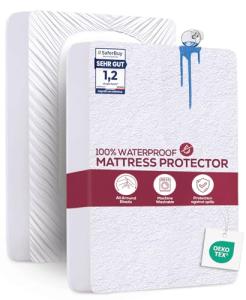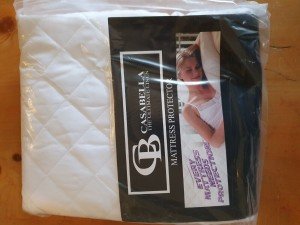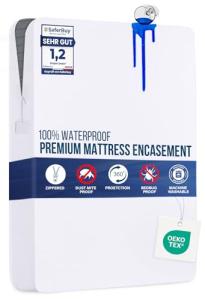In recent years, there has been an increasing awareness of the importance of maintaining a healthy sleeping environment. This is particularly primary for children, who are more susceptible to allergens. One effective way to ensure a clean and allergen-free environment is by using an anti-allergy mattress protector for bunk beds. This guide explores the benefits of such protectors, different types available, and tips for choosing the right one.
Understanding Allergies and Their Impact on Sleep
Allergies can significantly disrupt a child's sleep, leading to irritability, concentration issues, and even prolonged health problems. Common allergens found in bedding include dust mites, mold, pollen, and pet dander. When children sleep, they may breathe in these allergens, causing symptoms such as sneezing, nasal congestion, or skin irritation.
Key Allergens Found in Bedding
| Allergen | Source | Symptoms |
|---|---|---|
| Dust mites | Dead skin cells, humidity | Sneezing, itchy eyes, asthma attacks |
| Mold spores | Damp bedding | Nasal congestion, cough, skin rashes |
| Pollen | Seasonal changes | Sneezing, itchy eyes, running nose |
| Pet dander | Furred pets | Skin irritation, respiratory issues |
To mitigate these effects, parents often seek out methods to protect their children from allergens, making the use of anti-allergy mattress protectors a popular choice.
Benefits of Using Anti-Allergy Mattress Protectors
Investing in an anti-allergy mattress protector for bunk beds comes with numerous benefits, each contributing to improved health and sleep quality for children.
- Allergen Barrier: These protectors create a barrier between the mattress and potential allergens, preventing them from accumulating.
- Dust Mite Control: Anti-allergy protectors are typically designed to block dust mites, significantly reducing exposure to their droppings.
- Hypoallergenic Materials: Many of these protectors are made from hypoallergenic materials that do not irritate sensitive skin.
- Easy Maintenance: Most anti-allergy mattress protectors are machine washable, making it easy for parents to keep them clean and allergen-free.
- Waterproof Features: Some protectors come with waterproof membranes, which can safeguard the mattress against spills and accidents.
Types of Anti-Allergy Mattress Protectors
When looking for the ideal protector for a bunk bed, it’s important to understand the different types available. This knowledge can assist parents in making an informed decision that ensures optimal protection against allergens.
Key Types
- Zippered Encasement Protectors: These completely cover the mattress, creating an impenetrable barrier against dust mites and allergens.
- Fitted Sheet Style Protectors: These are designed to fit over the mattress like a fitted sheet, offering ease of use while still providing a certain level of protection.
- Topper Style Protectors: These are placed on top of the mattress and often feature additional cushioning for comfort, alongside allergy protection.
- Waterproof Protectors: Ideal for children, these protectors lock out moisture and allergens while also making it easy to clean up leaks or spills.
How to Choose the Right Anti-Allergy Mattress Protector
Selecting the right anti-allergy mattress protector can seem daunting with so many options available. However, several factors can help narrow down the choice:
Key Considerations
- Size: Ensure the protector fits the specific dimensions of the bunk bed mattress.
- Material: Look for breathable, soft, and hypoallergenic materials.
- Washability: Choose protectors that are machine-washable for easy maintenance.
- Water Resistance: For bunk beds used by younger children, waterproof models are ideal to deal with unexpected spills.
- Allergen Certifications: Seek products that are certified by allergy organizations to ensure effectiveness.
Maintenance of Anti-Allergy Mattress Protectors
Proper care of the mattress protector is essential for maintaining its effectiveness against allergens. Here are some maintenance tips:
- Regular Washing: Wash the protector every 1-2 weeks in hot water to kill dust mites and remove allergens.
- Drying: Always check the dryer temperature to avoid damage to waterproof layers; air drying may be preferable.
- Routine Cleaning: Take the opportunity to vacuum the mattress and surrounding areas during each wash to minimize allergen buildup.
Frequently Asked Questions (FAQs)
1. How often should I wash my anti-allergy mattress protector?
It is recommended to wash it every 1-2 weeks, or more frequently if your child has allergies.
2. Do anti-allergy mattress protectors prevent bed bugs?
While they can significantly reduce the risk of bed bugs, they should complement other preventive measures like regular cleaning and inspection.
3. Are anti-allergy mattress protectors safe for infants?
Yes, many protectors are designed with safe, non-toxic materials, but always read the packaging for specific age recommendations.
4. Can I use an anti-allergy protector on foam mattresses?
Absolutely! Most protectors are compatible with various types of mattresses, including memory foam and hybrid models.
5. Are there any specific allergens that anti-allergy protectors don’t protect against?
While they significantly reduce exposure to common allergens, they may not fully protect against all substances, such as certain mold spores or chemicals from household products.
An anti-allergy mattress protector for bunk beds is a wise investment for parents looking to create a healthy sleeping environment for their children. By understanding the benefits, types available, and the proper maintenance required, families can enjoy restful nights free from disruptive allergens. With increased awareness and proactive measures, it is possible to enhance the quality of sleep and overall health, ensuring kids wake up refreshed and ready for the day ahead.






